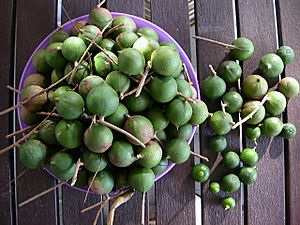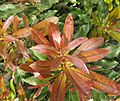Macadamia facts for kids
The macadamia nut is a tasty fruit that grows on a special tree. These trees first came from the eastern coast of Australia. There are different kinds of macadamia trees, but only one type is grown for us to eat.
The macadamia tree is an evergreen, which means it stays green all year long. It can grow up to about 25 feet (7.6 meters) tall! It has pretty groups of small white flowers. This tree loves warm, wet places, like subtropical areas. It needs soil where water can easily drain away and plenty of rain, about 40 to 100 inches (1000 to 2500 mm) each year.
The part of the nut we eat, called the nutmeat, is usually a creamy white color. Sometimes it looks a bit yellow. It has a delicious flavor that many people really enjoy! Macadamia nuts are often eaten roasted by themselves as a snack. They are also used to make yummy cookies, cakes, pastries, and candies. Some people even use them in cooked meals, similar to how they use almonds or cashews.
The very first farm to grow macadamias for selling started in Australia in the late 1880s. Then, in the 1920s, people began growing them in Hawaii. Later, macadamia farms spread to places like California and Mexico, and other warm areas around the world.
Here's an important fact: macadamia nuts are poisonous to dogs. If a dog eats them, it usually takes about 24 to 48 hours for them to feel completely better. The macadamia plant belongs to a family of flowering plants called Proteaceae.
Contents
What Does a Macadamia Tree Look Like?
Macadamia trees are evergreen plants that can grow from about 6.5 feet (2 meters) to 39 feet (12 meters) tall.
Leaves and Flowers
The leaves of the macadamia tree grow in groups of three to six. They can be long and narrow, or more oval-shaped. They are usually between 6 and 30 centimeters (2.4 to 12 inches) long and 3 to 13 centimeters (1.2 to 5.1 inches) wide. The edges of the leaves can be smooth or have small spines.
The flowers grow in long, thin clusters called racemes, which can be 5 to 30 centimeters (2 to 12 inches) long. Each individual flower is small, about 10 to 15 millimeters (0.4 to 0.6 inches) long. They can be white, pink, or even purple, and each flower has four petals.
The Fruit and Seeds
After the flowers, the tree grows a hard, woody, round fruit. This fruit has a pointed tip and usually holds one or two seeds inside. These seeds are the macadamia nuts we love to eat!
The History of Macadamia Nuts
Macadamia nuts have an interesting history, from their discovery to becoming a popular snack around the world.
Early Discoveries and Naming
- 1828: A European explorer named Allan Cunningham was the first to find the macadamia plant.
- 1857: A German-Australian scientist named Ferdinand von Mueller gave the plant its scientific name, Macadamia. He named it after his friend, Dr. John Macadam, who was a scientist in Australia.
- 1858: Walter Hill, who managed the Brisbane Botanic Gardens in Australia, saw a boy eating the nut without any problems. This was the first time a non-native person was recorded eating a macadamia nut.
First Growers and Traders
- 1860s: King Jacky, an elder from an Aboriginal tribe near Brisbane, Queensland, was one of the first known people to trade macadamias. His tribe regularly collected and traded the nuts with settlers.
- 1866: Tom Petrie planted macadamia trees at Yebri Creek in Australia. He got the nuts from Aboriginal people.
- 1882: William H. Purvis brought macadamia nuts to Hawaii. He planted them to act as a windbreak for sugar cane fields.
Commercial Farming Begins
- 1888: The very first farm meant to grow macadamias for selling was planted in Rous Mill, Australia, by Charles Staff.
- 1889: Joseph Maiden, an Australian botanist, wrote that macadamias were "well worth extensive cultivation" because people always wanted to buy the nuts.
- 1910: The Hawaiian Agricultural Experiment Station encouraged farmers in Hawaii to plant macadamias. They hoped it would be another crop to grow alongside coffee.
- 1916: Tom Petrie started trying out macadamia farms in Maryborough, Queensland, planting them with pecan trees to protect them.
Growing the Macadamia Business
- 1922: Ernest Van Tassel started the Hawaiian Macadamia Nut Co. in Hawaii.
- 1925: Tassel rented land in Honolulu and started Nutridge, Hawaii's first macadamia seed farm.
- 1931: Tassel opened a factory in Hawaii to process macadamia nuts. He sold them as "Van's Macadamia Nuts."
- 1937: Scientists Winston Jones and J. H. Beaumont from the University of Hawaii found a way to successfully graft macadamia trees. This was a big step that made it possible to grow many more trees.
- 1940s: Steve Angus in Australia started a small company called Macadamia Nuts Pty Ltd to process nuts.
- 1946: A very large macadamia farm was started in Hawaii.
- 1953: A company called Castle & Cooke launched a new brand of macadamia nuts called "Royal Hawaiian." This brand helped make the nuts very popular in the U.S.
Global Production Changes
- 1997: Australia started producing more macadamia nuts than the United States.
- 2012–2015: South Africa became the biggest producer of macadamias in the world.
- 2014: Macadamia nuts were in the news because of a famous "nut rage incident" on a Korean Air flight in New York City. This event made macadamia nuts much more visible in South Korea and led to a big increase in people buying them there.
Images for kids
See also
 In Spanish: Macadamia para niños
In Spanish: Macadamia para niños








